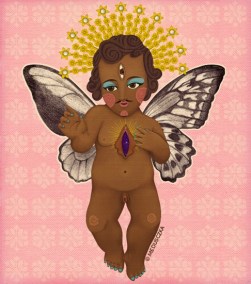
Reza Aslan says in his book “No God But God” that religions are myths. He explains that “religion” is a set of stories fluctuating between truth and fantasy that serve to explain and answer questions about human fate. Taking this idea as base, I think “religion” is a historical product that enables other mythical stories and must be addressed critically about its truth and meanings.
Patriarchal religious discourses, currently mainstream, have a common element that often is left outside the reading of equality and is part of the myth: Heterosexual belief.
Feminisms in Religions aim at challenging patriarchal readings. However, questioning the nature of God is not enough if we don´t challenge heterosexual belief that may or may not include the idea of a God Father/Male. In Islam, Allah has no sex or gender, is not masculine nor feminine. However, the heterosexual belief exists in the Islamic religious narrative.
When I talk about heterosexuality, I go beyond sexual or romantic attraction to the “opposite sex”. Heterosexuality is a compulsory regime and we are socialized into it; it’s not a choice. Not only does it describe a sexual orientation, it also carries a discipline of social organization, work and production relations, what is normal and what is not, who counts as people and who are others, as well as on how sexuality should be lived. The heterosexual regime is strongly supported by religious discourses through its features and institutions: androcentrism, marriage, binarism, hierarchy, ableism, subordination, reproduction, family and monogamy.
From my perspective, as a radical, critical and standing-alone Muslim Feminist, Islamic feminism does the task of questioning the status quo represented by Religious Patriarchy. However, from my commitment to a decolonial perspective, I think is time to go beyond into transformation and be courageous enough to engage deeply in challenging heteronormative paradigms, including those within ourselves.
Once dismantled the male centered hermeneutics comes to identify the anchors to hetero-patriarchal discipline that remain in feminist practices and narratives. Heterosexuality is printed in language and interactions, distribution of spaces, in representations and symbols. Whether Revelations say it or not, what matters in religions and feminisms, are the assumed practices and their actual consequences in the lives of people. A feminist perspective, truly engaged in creating an emancipatory frame for women’s liberation, could not longer endorse heterosexual discipline expressed in, for example:
- Attachment to the blatant binarism of “Equality for Men and Women” because “God created men and women”, leaving unquestioned how religious discourse supports the construction of these categories, the subsequent oppression and exclusion for women and non binary identities that derive from and sexist violence contained in the own metaphor of the difference of the sexes that is reproduced by the religious space from their legal, symbolic and organizational structures.
- In relation with the above, not challenging Motherhood and Marriage as institutions that facilitate and justify the seclusion of women in the private space. Worse than this, is using the patriarchal rhetoric about motherhood – since “Paradise is at the feet of mothers” – as proof of the progressivism of a given religious framework to avoid, consciously or not, the criticism on the heterosexual genealogy of its narrative.
- Being blind about the links between religion, patriarchy, heterosexuality and capitalism. A system of production and exploitation requires a discourse that endorses the supremacy of able (non-disabled) human beings over the creation or speciecism, as well compulsory reproduction based on sex /gender system that makes possible the availability of cheap labor and the segregation of people in reduced units of productions, as families. Italian feminist Silvia Federici, has developed extensively this topic.
Feminisms have or should have the ability of “Constant Wondering Outlook” and I consider that the more complex, intersectional, and troublesome and wide it can be, the better. Challenging religious patriarchy goes further than saying that God is not a male or to claim for a Female Divinity. The struggle against patriarchy is a half battle without fighting the heterosexual regime to eradicate the colonization of minds, bodies, identities and social practices imposed by it and opening doors to new possibilities of truths and subjectivities.
Heterosexuality is the expression of a dominant discourse, is the power of hegemony. Lacking of critical accountability about the strong attachment to heteronormative discipline in narratives, representations and praxis prevent any kind of feminism from growing and be dynamic. Talking critically and honestly on how religions endorse heterosexual regime, feminist theologies in general and Islamic Feminism in particular could achieve the development of a dissident, radical and decolonial theology to become a useful tool for gender justice at all levels, that allows women to claim back the agency on their lives as whole beings.
Featured Image: “Santa Niña Marica Mariposa Hermafrodita/ Intersexual” belongs to “Santas Niñas Maricas” series created by Trans- Feminist Meduzcka Gorgona (@medusczka) as an appropriation of symbolic characters in Mexican imagination to visibilize trans/ effeminate/ genderqueer/ hermaphrodites childhoods denied under the patriarchal idea that we are all born heterosexual, under the binarism of men and women. This is her blog.
Vanessa Rivera de la Fuente is a Writer, Mentor and Community Educator in Capacity Building for Grass Roots Female Leaders and Advocates. A Feminist who is an Independent Researcher of Gender and Islam on Feminist Hermeneutics, Muslim Women Representations, Queer Identities and Movement Building. She blogs in Spanish at Mezquita de Mujeres, a site dedicated to explore the links between Gender, Religion and Feminism as well to Women from the Global South as Change Makers in their communities.



An intriguing essay. Thank you. I look forward to more of your writing.
LikeLike
Thank you. Of course the topic can be adressed deeper.
LikeLike
Excellent and thought-provoking.
LikeLike
Thank you very much for reading it
LikeLike
I appreciate your noting the hollowness of the “Paradise lies at the feet of mothers” proverb, which covers the hell in the mothers’ hearts when they are divorced and lose custody of their children after a certain age.
It’s important to recognize that the problem goes well beyond heterosexuality, to codes that enforce patrilineality. That is the reason for the rigid sexual double standard in marriage, divorce, child custody, and the basis for anti-gay attitudes as well. In other words, heteronormativity is just one aspect of the larger problem of patriarchy.
LikeLike
I wish I could find words to express my appreciation for your opinion. But I only can say Thanks.
LikeLike
As I kept reading this, the novel “Circle of Stones” would not stop running through my mind. When men decided to mandate monogamy and realized they could, or so they thought, therefore control a woman and his children with her–the reason for monogamy–women became doomed to some form of patriarchy or another. How will we ever get beyond that?
LikeLike
One of the best articles I have read so far on gender justice in Islam. Thank you for your awesomeness!!
LikeLike
Thank you very much. Appreciated.
LikeLike
Each man and each woman makes the idea of God and Allah from religion.
Religion did not create us, but some of us created religion for different kinds of reasons.
A person, a state, a society or a sect can produce religion, which is an kind of consciousness of the world.
Each religion is a general theory of this world created ages ago, an old encyclopedia, a kind of old logic, a kind of spirituality, a kind of enthusiasm, a kind of moral sanction, solemn traditions, consolation and justification.
But what is true reality? What is God, Allah? Is a god something we worship? Is what we spend time with, our passion our god?
Religious suffering is the expression of real suffering and a protest against real suffering. Religion is the sigh of the oppressed individual, a heart in a heartless world, and the soul in the midst of soulless conditions.
Religion is the opium to soothe the pain from the reality of it all. However, reality does not hurt. It is our resistance to reality that hurts.
Why not try to understand reality deeply, look at the problems deeply, understand them deeply and then find solutions for the problems?
Remember to look at the problems sometimes created by religion itself!
https://en.wikipedia.org/wiki/Aisha
LikeLike
So? I don´t think you truly understand my article. Thanks
LikeLike